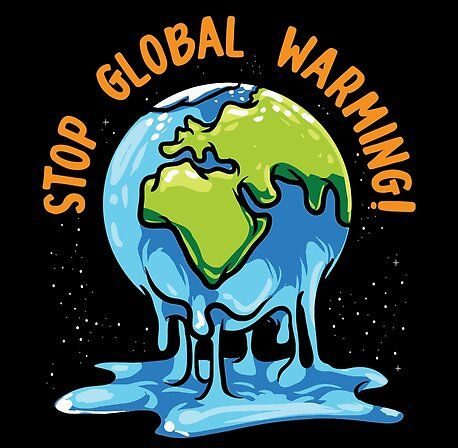Global Warming Metaphors
Metaphors are often used to help people understand complex concepts like global warming and climate change by drawing parallels with more familiar or tangible ideas. Here are a few metaphors that are commonly used to describe aspects of global warming:
Earth’s Blanket: This metaphor compares the Earth’s atmosphere to a blanket. Just as a blanket keeps us warm, the atmosphere traps heat and greenhouse gases, which is essential for maintaining a livable temperature. However, an excessive buildup of greenhouse gases is like adding too many blankets, causing the planet to overheat.
Carbon Footprint: The concept of a “carbon footprint” is often likened to leaving a trail or imprint on the Earth. It suggests that our actions and choices, such as driving cars or using electricity, leave behind a mark in the form of carbon dioxide emissions that contribute to global warming.
Tipping Point: This metaphor describes a critical threshold in a system. It’s often used to convey the idea that there’s a point at which climate change could become irreversible or lead to abrupt and severe consequences. Just as a boat can tip if too much weight is added on one side, the climate system can become unstable if pushed too far.
Climate Change as a Fever: This metaphor compares the Earth’s rising temperature to a person with a fever. A small increase in temperature might not seem significant, but when it’s persistent and exceeds a certain threshold, it can have serious consequences for the planet, just as a high fever can indicate a health problem.
Slow Motion Disaster: Climate change is sometimes described as a “slow-motion disaster” to emphasize that its impacts are gradual and unfolding over time, similar to how a disaster might unfold in a movie or a book. This metaphor highlights the need for proactive, long-term solutions.
Iceberg Melting: This metaphor draws a parallel between the visible and hidden aspects of climate change. Just as most of an iceberg is hidden underwater, many climate change consequences are not immediately visible. However, as the iceberg melts, it becomes more evident, symbolizing the growing awareness of climate change impacts.
A World on Fire
Imagine a world engulfed in flames, each forest and coastline a tinderbox waiting to ignite. This metaphor captures the urgency of the climate crisis. The Earth, like a wildfire, is in dire need of containment and restoration. Also, read about the Global Warming Scam
Earth’s Fever
Another common metaphor likens global warming to the planet having a fever. Just as a high temperature is a sign of illness in the human body, the Earth’s rising temperature signals distress. The metaphor is apt to highlight the health of our planet.
The Scorching Planet
A scorching planet paints a vivid picture of the relentless heat waves and melting ice caps. It’s a metaphor that conveys the harsh reality of global warming. The Earth, once lush and temperate, is rapidly transforming into an inhospitable desert.
Unleashing the Climate Beast
The notion of climate change as a monstrous beast emphasizes the uncontrollable nature of the crisis. This metaphor reminds us that our actions have awakened a titan that is wreaking havoc on our world. Don’t forget to visit our website globallbrowse.com
Taming the Climate Monster
While the climate beast is fearsome, this metaphor also offers hope. It suggests that through collective efforts, we can tame the climate monster and restore the balance we so desperately need.
The Perils of Awoken Titans
This metaphor urges us to acknowledge the perils we face when we disregard our planet’s health. Just as ancient myths warn of the consequences of disturbing powerful beings, the metaphor warns us of the consequences of neglecting our environment.
The Climate Jigsaw
Thinking of climate change as a complex jigsaw puzzle reminds us that every piece of the climate system is interconnected. Disturbing one piece can have far-reaching consequences, just like a misplaced jigsaw piece disrupts the whole picture.
The Earth’s Thermometer
Comparing the Earth to a thermometer underscores how climate change serves as a diagnostic tool for our planet’s health. Rising temperatures indicate a problem that needs addressing.
The Fragile Climate Equilibrium
The metaphor of a fragile climate equilibrium emphasizes the delicate balance that has sustained life on Earth for eons. Human activities threaten this equilibrium, and it’s our responsibility to restore it.

Climate Change as a Human-Made Dilemma
This metaphor places the blame squarely on human actions. It reminds us that global warming is a crisis we have created and one we must resolve.
Humanity’s Carbon Footprint
The idea of a carbon footprint signifies the environmental impact of human activities. It’s a reminder that each step we take leaves an imprint on the Earth’s climate.
Nurturing Our Ailing Planet
The metaphor of nurturing our ailing planet suggests that just as we care for a sick loved one, we must care for the Earth. Our planet, suffering from global warming, needs our attention and care.
Conclusion
In conclusion, global warming metaphors offer a unique lens through which we can understand the urgency and complexity of the climate crisis. These metaphors make the abstract tangible and compel us to take action. As we confront the challenges of global warming, let these metaphors guide our collective efforts to protect the planet.
FAQs
What are metaphors in the context of global warming?
Metaphors in the context of global warming are figurative expressions that help convey the severity and nuances of the climate crisis. They provide a relatable way to understand the complex issue.
Why are metaphors important in environmental discourse?
Metaphors are important in environmental discourse because they make abstract concepts tangible and relatable. They can drive home the urgency of the climate crisis and inspire action.
How can metaphors like “Earth’s Fever” impact our perception of global warming?
Metaphors like “Earth’s Fever” can impact our perception of global warming by framing it as a health issue. This can evoke empathy and a sense of responsibility towards the Earth’s well-being.
Do metaphors influence public perception of climate change?
Yes, metaphors can influence public perception of climate change. They have the power to simplify complex ideas and emotions, making it easier for people to grasp the seriousness of the issue.
What can individuals do to address global warming, as suggested by the metaphor “Nurturing Our Ailing Planet”?
Individuals can address global warming by taking steps to reduce their carbon footprint, support environmental initiatives, and advocate for sustainable practices, as implied by the metaphor “Nurturing Our Ailing Planet.”







